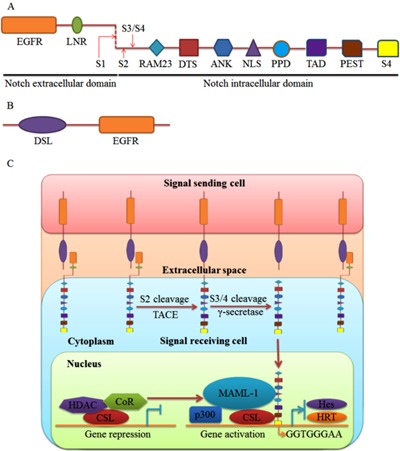Figure 1. Schematic representation of Notch signaling. A, Notch receptor is composed of extracellular and intracellular domains. The extracellular domain consists of EGFR and LNR. The intracellular domain contains RAM23, DTS, ANK, NLS, PPD, TAD, PEST, and S4. The red arrows indicate cleavage sites: S1 (Furin), S2 (TACE), and S3/S4 (γ-secretase). B, Notch ligands have DSL and EGFR domains. C, Notch signaling transduction pathway ligand-receptor interaction leads to two successive cleavages at S2 by TACE and S3/4 by γ-secretase to release NICD. NICD translocates to the nucleus and forms a transcriptional activation complex after binding to MAML-1 and CSL. Prototypic target genes include Hes and the HRT family members. EGFR: epidermal growth-like repeats; LNR: LIN12/Notch repeats; RAM: RBP-Jκ associated molecule; DTS: downregulation targeting sequence; ANK: ankyrin/cdc10 repeats; NLS: nuclear localization signals; PPD: potential phosphorylated domain; TAD: transcriptional activation domain; PEST: sequence rich in proline, glutamic acid, serine, and threonine; S4: WSSSSP; TACE: TNF-α converting enzyme; DSL: Delta, Serrate, Lag2; NICD: Notch intracellular domain; MAML-1: Mastermind-like 1; CSL: C promoter-binding factor in humans, Suppressor of hairless in Drosophila, LAG in Caenorhabditis elegans, also called RBP-Jκ in mice; Hes: Hairy and enhancer of split; HRT: Hairy-related transcription; CoR: co-repressor; HDAC: histone deacetylase.

